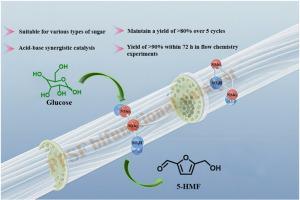酸碱双官能团聚苯硫醚纤维催化生物质糖转化5-羟甲基糠醛
IF 5.8
2区 生物学
Q1 AGRICULTURAL ENGINEERING
引用次数: 0
摘要
本研究介绍了一种具有酸碱双官能团的聚苯硫醚(PPS)纤维催化剂C-PPS-SN5/1,用于将生物质糖转化为5-羟甲基糠醛(5-HMF)。该催化剂通过多步过程将磺酸和叔胺基团结合,提供协同催化。其创新的PPS光纤设计具有共价键合位点,确保了卓越的稳定性和可扩展性。通过SEM, XRD, FTIR, XPS表征和力学测试证实了其结构完整性,成功接枝和耐久性,在五次循环后保持超过51%的强度。通过优化反应参数,包括酸碱比(5:1)、溶剂体系(NaCl(20% wt)/DMSO, 1:4 v/v)、温度(葡萄糖160°C、果糖120°C)和催化剂负载(5 mol%),获得了92%(葡萄糖)和95%(果糖)的收率,选择性分别为97%和95%。该催化剂具有广泛的底物适用性,可将蔗糖、麦芽糖、半乳糖、淀粉和纤维素转化为5-羟甲基糠醛,收率高达94%。值得注意的是,C-PPS-SN5/1具有出色的可回收性,在5个循环中保持80%的收率,并且在连续流操作中稳定(72 h收率达到90%)。这些结果强调了催化剂在工业环境中可扩展、可持续生物质增值的潜力。本文章由计算机程序翻译,如有差异,请以英文原文为准。

Conversion of biomass sugar to 5-hydroxymethylfurfural catalyzed by acid-base bifunctional polyphenylene sulfide fiber
This study introduces C-PPS-SN5/1, a polyphenylene sulfide (PPS) fiber catalyst with acid-base bifunctionality for converting biomass sugars to 5-hydroxymethylfurfural (5-HMF). The catalyst combines sulfonic acid and tertiary amine groups through a multi-step process, offering synergistic catalysis. Its innovative PPS fiber design with covalently bonded sites ensures exceptional stability and scalability. Characterization through SEM, XRD, FTIR, XPS, and mechanical tests confirmed its structural integrity, successful grafting, and durability, retaining over 51 % strength after five cycles. By optimizing reaction parameters—including acid-base ratio (5:1), solvent system (NaCl(20 % wt)/DMSO, 1:4 v/v), temperature (160 °C for glucose; 120 °C for fructose), and catalyst loading (5 mol%)—exceptional yields of 92 % (glucose) and 95 % (fructose) were achieved with selectivities of 97 % and 95 %, respectively. The catalyst demonstrated broad substrate applicability, converting sucrose, maltose, galactose, starch, and cellulose to 5-HMF with yields up to 94 %. Remarkably, C-PPS-SN5/1 exhibited outstanding recyclability, maintaining >80 % yield over five cycles, and stability in continuous flow operation (>90 % yield for 72 h). These results underscore the catalyst's potential for scalable, sustainable biomass valorization in industrial settings.
求助全文
通过发布文献求助,成功后即可免费获取论文全文。
去求助
来源期刊

Biomass & Bioenergy
工程技术-能源与燃料
CiteScore
11.50
自引率
3.30%
发文量
258
审稿时长
60 days
期刊介绍:
Biomass & Bioenergy is an international journal publishing original research papers and short communications, review articles and case studies on biological resources, chemical and biological processes, and biomass products for new renewable sources of energy and materials.
The scope of the journal extends to the environmental, management and economic aspects of biomass and bioenergy.
Key areas covered by the journal:
• Biomass: sources, energy crop production processes, genetic improvements, composition. Please note that research on these biomass subjects must be linked directly to bioenergy generation.
• Biological Residues: residues/rests from agricultural production, forestry and plantations (palm, sugar etc), processing industries, and municipal sources (MSW). Papers on the use of biomass residues through innovative processes/technological novelty and/or consideration of feedstock/system sustainability (or unsustainability) are welcomed. However waste treatment processes and pollution control or mitigation which are only tangentially related to bioenergy are not in the scope of the journal, as they are more suited to publications in the environmental arena. Papers that describe conventional waste streams (ie well described in existing literature) that do not empirically address ''new'' added value from the process are not suitable for submission to the journal.
• Bioenergy Processes: fermentations, thermochemical conversions, liquid and gaseous fuels, and petrochemical substitutes
• Bioenergy Utilization: direct combustion, gasification, electricity production, chemical processes, and by-product remediation
• Biomass and the Environment: carbon cycle, the net energy efficiency of bioenergy systems, assessment of sustainability, and biodiversity issues.
 求助内容:
求助内容: 应助结果提醒方式:
应助结果提醒方式:


